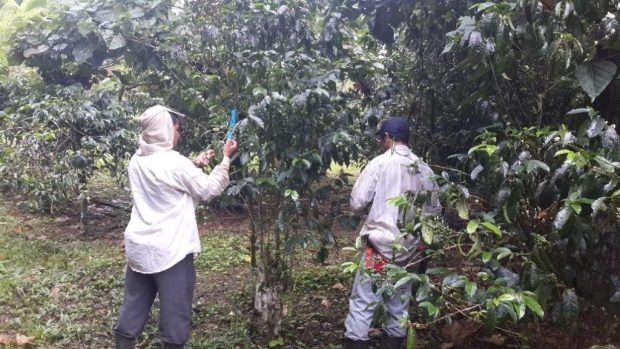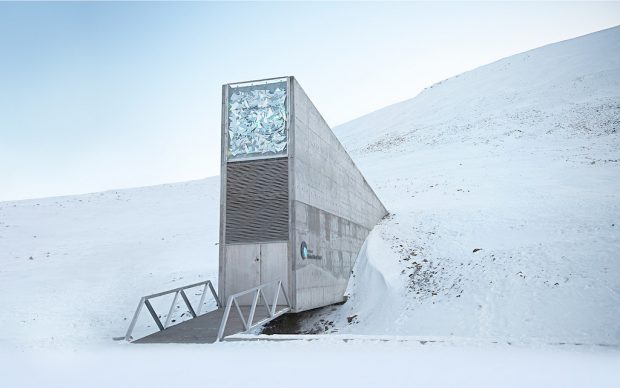
In Costa Rica, CATIE is one of the most robust coffee gene banks in the world, with more than 900 genetic varieties. However, because many of the plants had reached an advanced age, the bank lost 750 plants over a three-year period in the 1990s. There are approximately 19 coffee gene banks in the world, in addition to wild Ethiopian coffee in forests. All images courtesy of World Coffee Research.
From a biological perspective, there are two major factors at play threatening the world’s long-term supply of coffee: climate change and coffee’s lack of genetic diversity in response.
Climate experts have already warned that lands currently being used to grow arabica are being affected by changes in weather patterns, negatively impacting production with increased incidences of drought, plant-attacking diseases and pests. Climate modeling suggests that half of the land in which coffee is currently grown may be unsuitable for coffee growth within less than 35 years time.
Faced with this, a number of groups within the coffee world have embarked upon the development of new coffee varieties that can potentially tolerate such natural threats — those that are current existing, and those yet unseen that may develop as climate changes. Unfortunately, coffee has already proven to have a remarkable lack of genetic diversity, meaning there is a naturally limited palette of genetic traits with which to work.
With this in mind, Texas-based World Coffee Research has teamed up with the Global Crop Diversity Trust to develop a global coffee conservation strategy for coffee diversity, the first global effort of its kind in coffee. “Do we want to have a coffee industry in 100 years,” WCR’s Hanna Neuschwander asked in a recent interview with Daily Coffee News. “If so, then we need to do this.”

Dr. Sarada Krishnan is leading the study for WCR and Crop Trust, and announced the program at a gathering of 50 nations in Washington DC on April 15.
The immediate plan is being executed largely by Dr. Sarada Krishnan, director of horticulture and the Center for Global Initiatives at the Denver Botanic Gardens. Krishnan will in essence be taking as much inventory as possible at the world’s 19 existing gene banks for coffee, in addition to wild coffee in forests. Neuschwander said Krishnan will then take site visits to five of the world’s biggest, most diverse gene banks over the summer in order to form a conservation plan to be presented at the International Coffee Organization meeting this coming September.
Unfortunately, coffee also proves tricky in gene banking. Most other crops can be stored in seed form in places like Crop Trust’s Svalbard Global Seed Vault — a.k.a. the “Doomsday Vault,” built into a remote island halfway between mainland Norway and the North Pole that looks something like a lair for a James Bond villain. Seeds there are stored in sealed, moisture-free bags in permafrost conditions, and protected by rigorous security measures.
Coffee gene banking, meanwhile, requires actual plants in the ground, meaning coffee gene banks tend to simply resemble coffee farms — and, like coffee farms, the banks are susceptible to natural threats such as pests or leaf rust. Further, coffee’s already limited number of gene banks tend to be run by governments or affiliated organizations that may struggle to maintain proper funding for bank growth or maintenance. Said Neuschwander, “You have to keep your gene bank for coffee in a living field of trees, which is why many of these gene banks are in disrepair.”
One likely result of the initiative will be a proposed plan for multi-national collaboration for protecting and improving coffee’s gene banks and supporting coffee’s genetic diversity as a whole. A strategy for how to do that exactly will most likely be laid out by the Trust later this year, while establishing conservation funding goals and attempting to engage the private sector are potentially likely. “I don’t know what kind of funding targets they are going set,” Neuschwander said of the Trust, “but I could totally see a coffee company saying, ‘Yeah, we want to be the company that saves coffee forever.'”

WCR breeders collecting coffee flowers from one of the trees so that it’s pollen can be harvested. The pollen will be painted onto the flower of another tree — the cherry that results from this plant sex will be a new hybrid variety.
Nick Brown
Nick Brown is the editor of Daily Coffee News by Roast Magazine.
Comment
2 Comments
Comments are closed.







Thanks for the great read. I had no idea that banking coffee couldn’t be done like traditional seeds. Good to know there are people working to preserve biodiversity.
The Crop Trust is doing great work, another NGO based in Bonn.